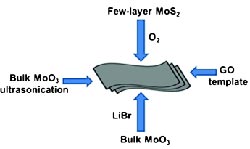Fast Pollutant Degradation by Nanosheets

<br>
Waste from textile and paint industries often contains organic dyes such as methylene blue as pollutants. Photocatalysis is an efficient means of reducing such pollution, and molybdenum trioxide (MoO3) catalyzes this degradation.
Researchers from Bangalore, India, led by C. N. R. Rao now report no less than four methods to produce nanosheets made of very few layers of MoO3. This material is more efficient as a photocatalyst than bulk MoO3, they write in Chemistry—An Asian Journal.
The n-type semiconductor molybdenum trioxide is used widely in heterogeneous catalysis. The Indian team prepared nanosheets of MoO3 by oxidation of MoS2 nanosheets, by using graphene oxide as a template, and by intercalation with LiBr into the bulk material or its ultrasonication.
When used as a photocatalyst in the degradation of methylene blue, a heterocyclic aromatic dye, the researchers found few-layered MoO3 to afford nearly complete degradation of the dye in less than 10 minutes, whereas only about one-third of the dye was degraded during this period with the bulk compound.
“As MoO3 holds great potential in applications ranging from gas sensing to energy storage, our study will likely spur further research on few-layer MoO3,” says Rao. Indeed, further results reported in their study suggest that a composite of this material with a borocarbonitride is promising as an electrode material for supercapacitors. It will be interesting to see what is coming next for this intriguing few-layer nanostructure.
About the Author
C. N. R. Rao is a National Research Professor, Linus Pauling Research Professor and Honorary President of the Jawaharlal Nehru Centre for Advanced Scientific Research, Bangalore, India. He holds over 50 honorary doctorates and is a member of over 20 national academies. His research is focused on solid state and materials chemistry, as well as structural chemistry. He is a member of the international advisory board of Chemistry—An Asian Journal.
Author: C. N. R. Rao, Jawaharlal Nehru Centre for Advanced Scientific Research, Bangalore (India), http://www.jncasr.ac.in/cnrrao/
Title: Synthesis, Characterization, and Properties of Few-Layer MoO3
Chemistry – An Asian Journal, Permalink to the article: http://dx.doi.org/10.1002/asia.201300470
Media Contact
More Information:
http://www.wiley.comAll latest news from the category: Life Sciences and Chemistry
Articles and reports from the Life Sciences and chemistry area deal with applied and basic research into modern biology, chemistry and human medicine.
Valuable information can be found on a range of life sciences fields including bacteriology, biochemistry, bionics, bioinformatics, biophysics, biotechnology, genetics, geobotany, human biology, marine biology, microbiology, molecular biology, cellular biology, zoology, bioinorganic chemistry, microchemistry and environmental chemistry.
Newest articles

Why getting in touch with our ‘gerbil brain’ could help machines listen better
Macquarie University researchers have debunked a 75-year-old theory about how humans determine where sounds are coming from, and it could unlock the secret to creating a next generation of more…

Attosecond core-level spectroscopy reveals real-time molecular dynamics
Chemical reactions are complex mechanisms. Many different dynamical processes are involved, affecting both the electrons and the nucleus of the present atoms. Very often the strongly coupled electron and nuclear…

Free-forming organelles help plants adapt to climate change
Scientists uncover how plants “see” shades of light, temperature. Plants’ ability to sense light and temperature, and their ability to adapt to climate change, hinges on free-forming structures in their…





















